How to Plant and Water Succulents In Pots Without Drain Holes
Learn how to plant and water succulents in pots without drain holes, and find out what you need to do and know to keep them healthy.
Here is the most important thing you need to know about succulents: they don’t like wet soil.
A couple of ways to keep them from rotting is to make sure the soil mix has good drainage and the water all runs out.
But what happens if you have no hole in the bottom of your pot? Here you’ll learn all about planting, and watering, succulents in pots with no drain holes.
Can you use pots without drainage holes?
Succulents pots with no drainage of any type are doomed from the get go. Succulents hold and storre water in their leaves and stems as well as their roots.
Water them too often, and plainly put, they will be subject to root rot and will turn to mush. They like to dry out in between waterings and that’s why it’s a good idea to plant them in pots with drain holes.
This guide was first published on November 11, 2017. It was updated on July 31, 2021 with more info, a new video & to answer some of your frequently asked questions which you’ll find at the end!
Check out the video below! I’m at my work table planting & watering succulents in pots with no drainage holes.
Many decorative pots come with no drainage holes. Every now and then you find a container you love, and what to do?
What to do with pots that have no drainage holes
I’m a container nut, as well as a plant addict, and every now and then find a pot I must have (yes, simply must have!) without a hole in the bottom of the pot. There are 2 options of what to do: drill holes or plant with a good amount of drainage materials.
I frequently drill into the bottom of pots to create or add drainage holes. I didn’t want to take a chance on the glossy red one cracking because it has a very thick bottom. My Hatiora, aka Dancing Bones or Drunkard’s Dream, prompted me to do this project initially.
This epiphytic cactus had just been sitting in its grow pot inside the decorative one so it was high time to get it planted in. I’ll need to repot it in a year or 2 but for now, it’s just fine.
Update: it ended up staying in this red pot for almost 5 years and just got repotted into a terra cotta footed pot with 1 large drain hole. You’ll see it in the video. So, succulents in pots without drain holes can do fine just as long as you provide drainage materials and water them correctly.
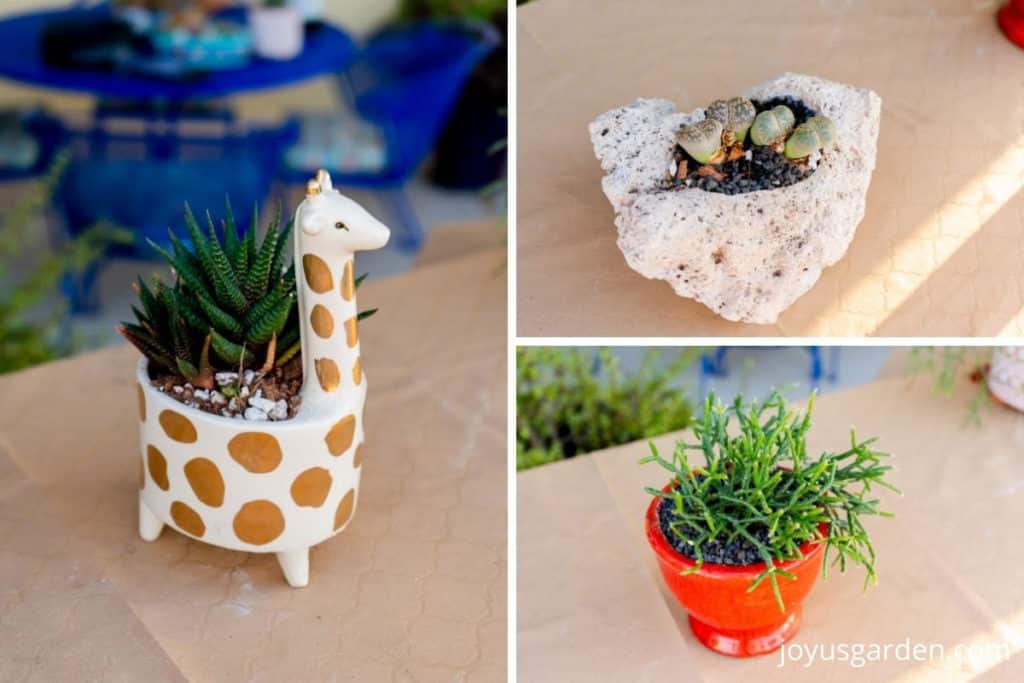
Pot Choice
There are many pots available in an array of materials, shapes, colors, and styles. When it comes to succulents, I prefer those with drainage holes. You may find 1 or 2 that don’t have any, and that is what this post is all about.
What are the best pots or the right pot? I say the ones that you like the best! I prefer terra cotta pots or ceramic pots to display my succulents in.
Succulent Choice
Any succulent plants you buy in a small grow pot will be fine repotted into a pot without drain holes for at least 6-12 months. That is, assuming you don’t over water it.
Here’s my list of best indoor succulents to consider if you’re a beginning gardener: String Of Bananas, Aloe Vera plant, Haworthias, String Of Buttons, Christmas Cactus, Hens and Chicks, Burro’s Tail Sedum (be careful, their leaves fall off in a heartbeat!), Flowering Kalanchoes, Calandivas, Jade Plants (there are a few varieties to choose from), Elephant Bush, Gasteria and Panda Plant.
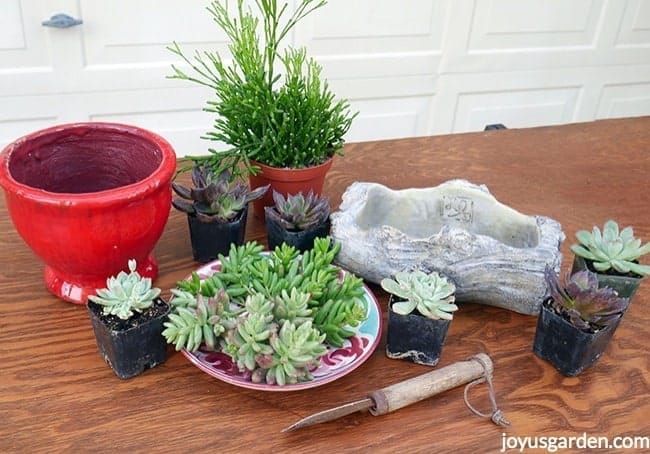
Want to learn more about how to care for succulents indoors? Check out these guides!
- How to Choose Succulents and Pots
- Small Pots for Succulents
- How to Water Indoor Succulents
- 6 Most Important Succulent Care Tips
- Hanging Planters for Succulents
- 13 Common Succulent Problems and How to Avoid Them
- How to Propagate Succulents
- Succulent Soil Mix
- 21 Indoor Succulent Planters
- How to Repot Succulents
- How To Prune Succulents
- How To Plant Succulents In Small Pots
- Planting Succulents In A Shallow Succulent Planter
- How to Plant and Water Succulents in Pots Without Drain Holes
- Indoor Succulent Care for Beginners
- How To Make & Take Care Of An Indoor Succulent Garden
How to Plant Succulents in Pots without Drainage Holes
1.) Add a layer at bottom of the pot
Put a layer of gravel, rock or pebbles on the bottom of the pot.
The size and depth of the rock depends on the size of the pot and the succulent(s) you are planting. Sometimes it’s hard to know what to use until you see the size of the root ball.
If you’re planting a 4″ pot, 1″ rock just doesn’t make sense, using pebble is a good idea. Conversely, if you have a larger pot (more than 8″ deep), then larger rock would be fine.
As an example, the red pot is 7″ wide x 5″ deep and I used 1/4″ pebble. I also like clay pebbles and lava rock when creating a drainage layer because both are porous. When repotting the Mistletoe Cactus into this red pot years later, I used lava rock and charcoal.
2.) Add a layer of charcoal
Spread a 1/2″ (again this will vary depending on pot size) layer of charcoal over the rock.
This is optional but what charcoal does is improve the drainage along with absorbing impurities and odors. For this reason, it’s great to use a layer or add into your soil mix when doing any indoor potting project.
The gravel, rock, or pebbles combined with the charcoal provide a buffer in between the roots and any extra water that might build up in the pot of the pot.
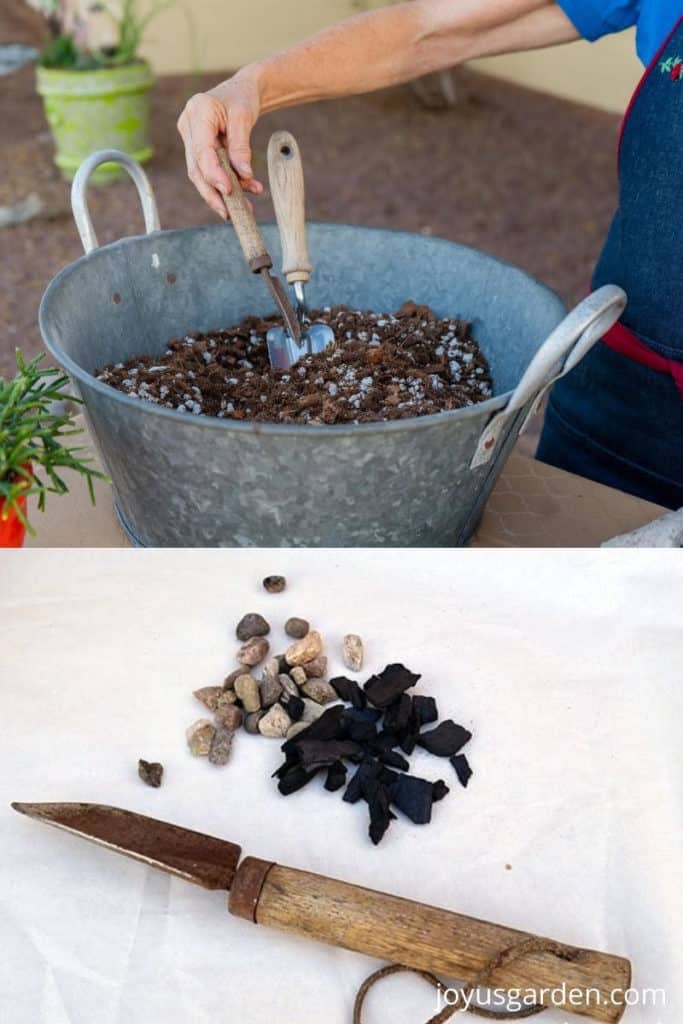
3.) Add a layer of succulent and cactus mix
Add a bit of succulent and cactus mix on top of the charcoal to raise the root ball up slightly higher than the rim of the pot.
The weight of the succulent will eventually pull it down in the light mix. I use this DIY recipe to make my own succulent and cactus mix. It contains chunks of pumice and coco chips and is very chunky ensuring excellent drainage and aeration. Those succulent roots don’t like any excess moisture!
If you’re using a store bought succulent and cactus mix like this one, you might consider adding some pumice or perlite to further up the ante on the aeration and lightness factor.
You might find this post dedicated to succulent soil mix to be helpful.
4.) Use worm compost
Fill in around the sides of the root ball with the succulent mix and top with a thin (1/4″) layer of worm compost.
This is optional but it’s my favorite amendment. I use this sparingly because it’s rich and breaks down slowly. I often use compost too. Here’s how I feed my indoor plants naturally with worm compost and compost.
5.) Let the succulents settle in
Let my succulents settle in for 5 to 7 days and then water.

How to water succulents without drainage holes
To control how much water you give succulents in pots without drainage holes, consider using a measuring tool like a cup or even a turkey baster.
I now use and recommend this squeeze bottle with the long neck for watering smaller-sized pots. It’s so easy to control the amount of water going into the soil mix with this device.
I watered my Hatiora (the cactus that was planted in the red pot) every 2 weeks and backed off to every 3-4 weeks in the winter. I used approximately a 1/4 cup of water per watering .
I live in the Arizona desert where temps are in the 80’s and the sun is still shining strong even in early November. You might need to water less often if you’re in a climate with cold, darker winters.
How often and how much you water succulents depends on the light, temperature, size of the rootball and size of the pot.
Water even less in the winter because the plants are “resting” at this time and don’t need as much. And, don’t mist or spray succulents on a weekly basis. They’re fine without it so save the misting for your tropical houseplants.
This type of planting is best done with succulents growing indoors. If you put your succulents in pots with no drain holes outside for the summer, make sure they’re protected so they don’t get rained on.
How to Keep Succulents in Pots Without Drain Holes Alive
The key to keeping them alive is in the watering. It’s better to under water than over water when it comes to succulents. You want them to dry out in between waterings.
FAQS About Succulents & Pots without Drainage Holes
If you’re a beginning succulent gardener, getting a pot with drain holes is a good idea. As you get more confident with succulent watering and care, you can give one a go!
It depends on how big the pot &/or drain hole is. I prefer at least 3 when it comes to succulents.
If the pot has no drainage holes, then I do a layer of pebbles, lava rock, or clay pebbles with a layer of charcoal over that.
In general, succulent roots grow more horizontally than they do vertically. Unless it’s a taller growing succulent like a Pencil Cactus, less deep is better.
Potting soil tends to be heavier and holds more moisture. This makes succulents more prone to over watering when planted in potting soil. A succulent and cactus mix holds less water and has the proper drainage and aeration that succulents need.
It’s tough to say how often your succulents growing indoors should be watered because there are so many variables involved.
I threw this one in because it’s a commonly asked question. I recommend succulent pots with drainage. I prefer terra cotta pots and ceramic pots for my succulent houseplants. Unglazed terra cotta and ceramic are both porous. This ups the ante on the aeration factor a bit if you’re directly planting the succulent into the pot.
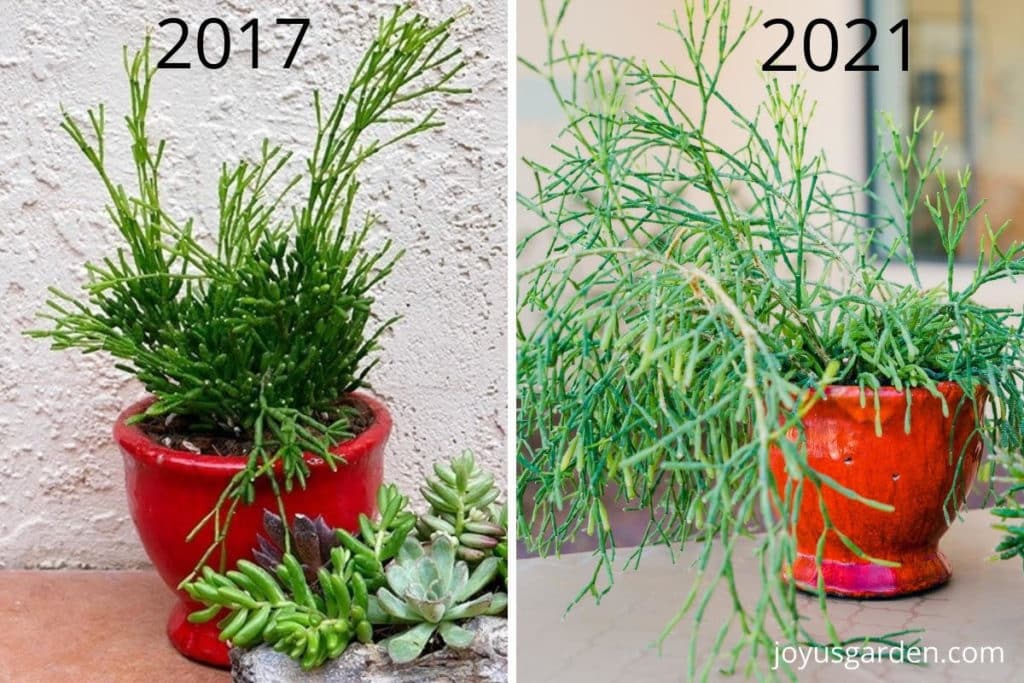
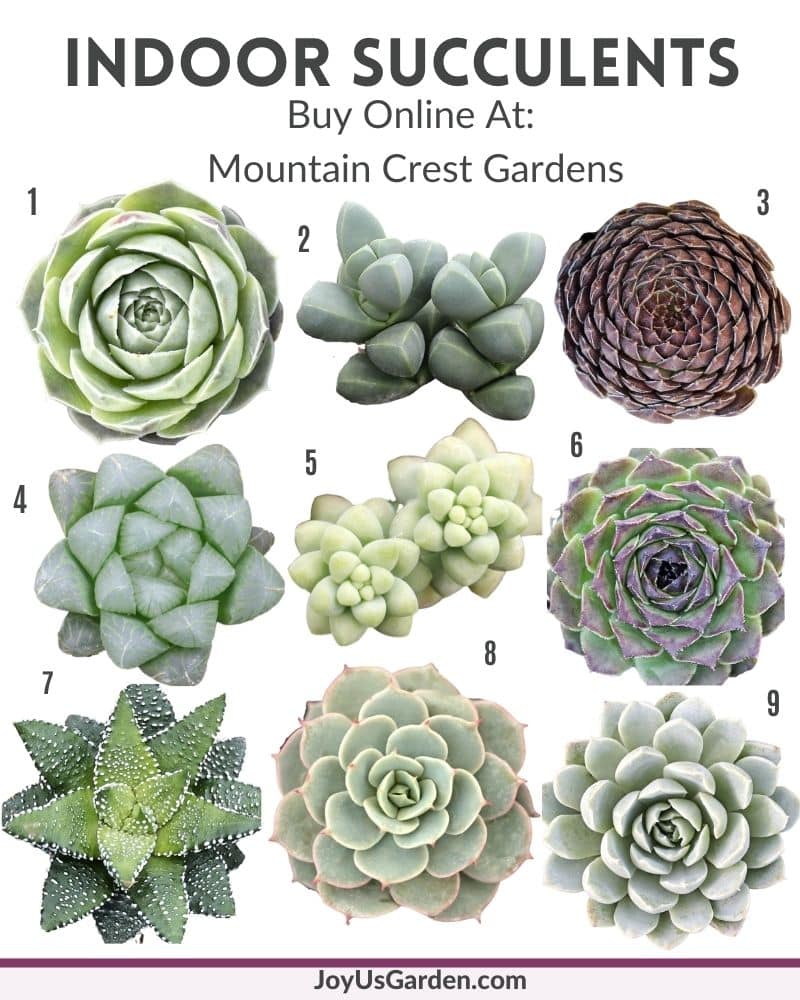
1. Sempervivum heuffelii // 2. Sedum morganianum // 3. Sempervivum saturn // 4. Haworthia cooperi var. truncata // 5. Corpuscularia lehmannii // 6. Sempervivum tectorum // 7. Haworthia attenuata // 8. Echeveria Fleur Blanc // 9. Echeveria albicans
Conclusion
The bottom line is that plants need drainage. I don’t usually don’t encourage planting in pots with no drain hole but every blue moon you find a special pot which doesn’t have one. So, just plant appropriately, go easy on the watering and enjoy that beautiful succulent and pot!
Happy gardening,

This post may contain affiliate links, you can read our policies here.
- About the Author
- Latest Posts
Nell, the founder of Joy Us garden, was born into a gardening family and grew up in Connecticut’s countryside. After living in Boston, New York, San Francisco, & Santa Barbara, she now calls the Arizona desert home. She studied horticulture & garden design, working in the field all her life. Nell is a gardener, designer, blogger, Youtube creator, & author. She’s been gardening for a very long time & wants to share what she’s learned with you.
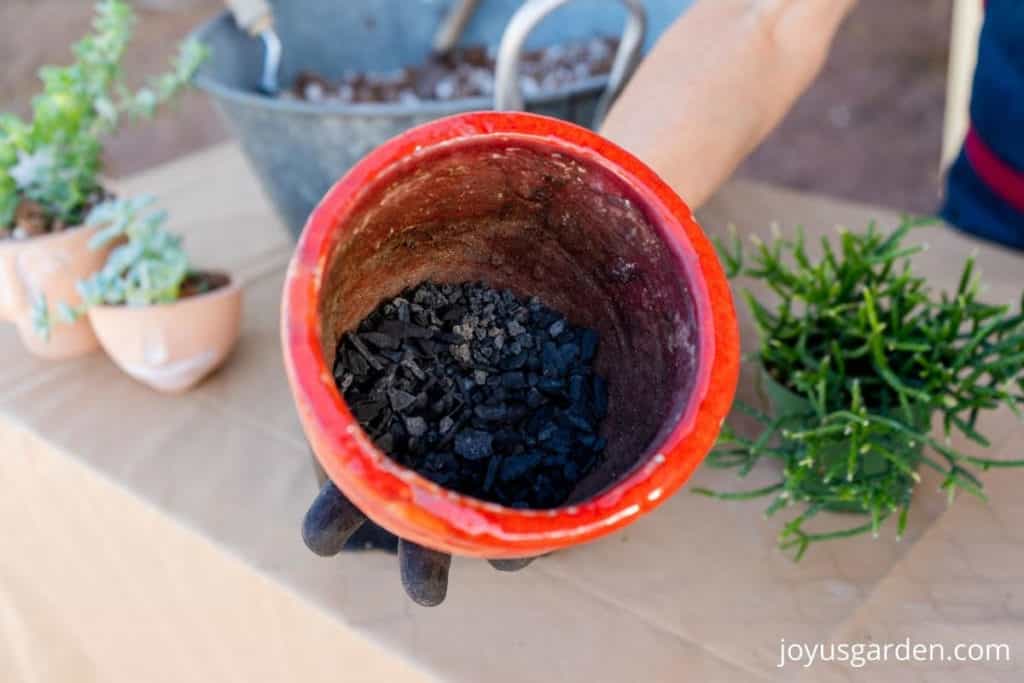
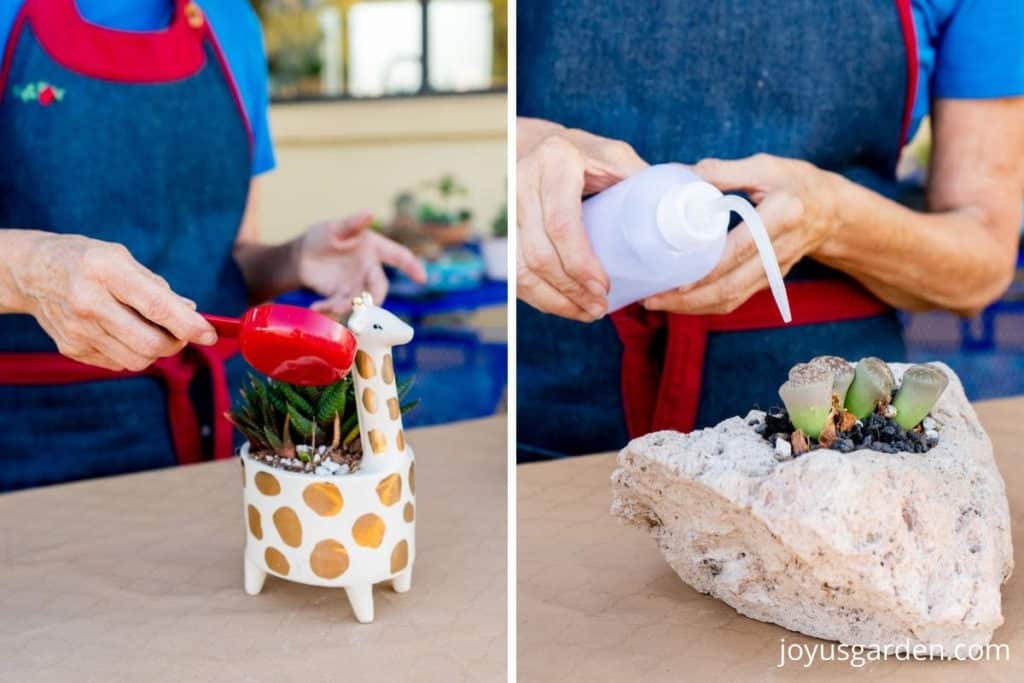
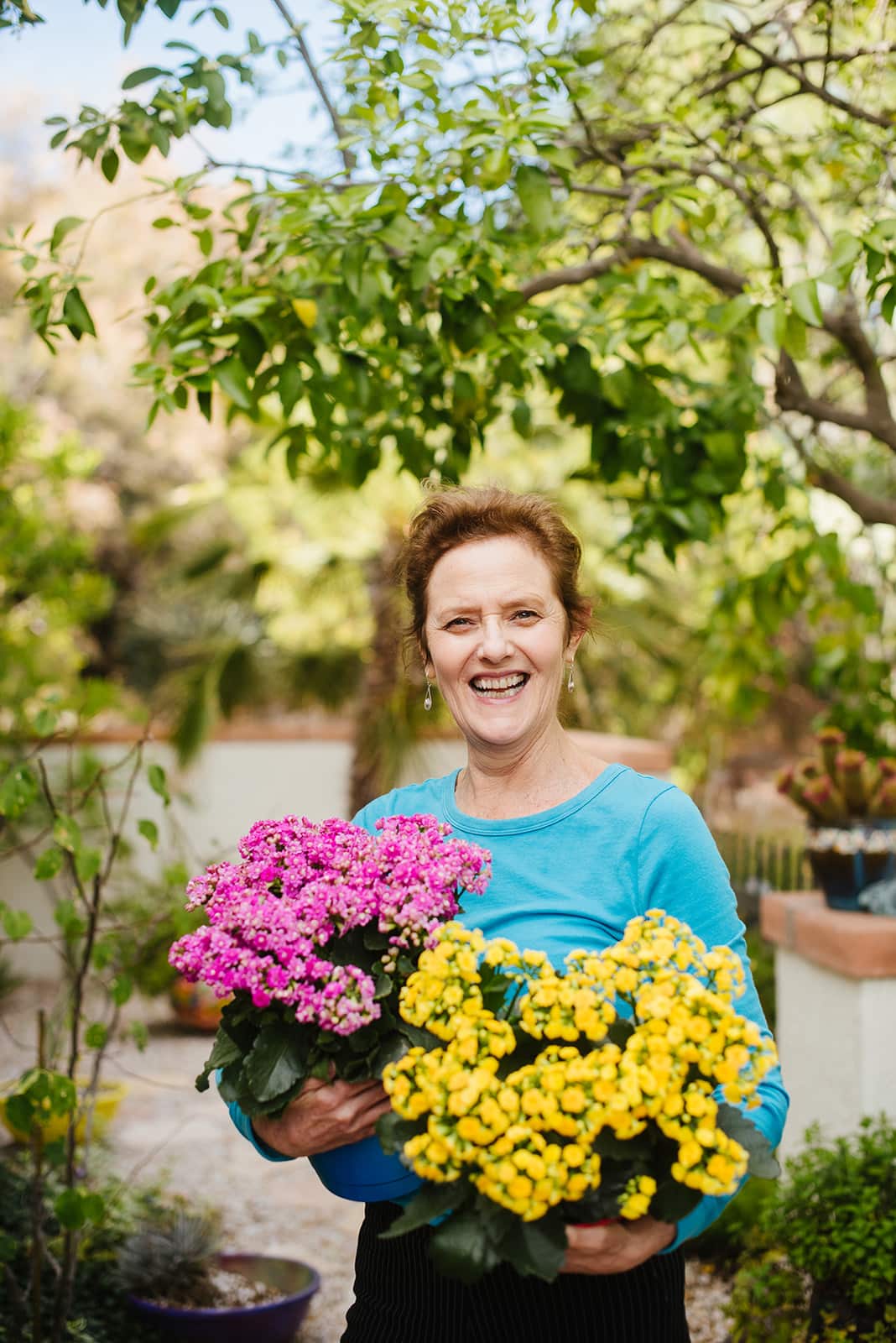
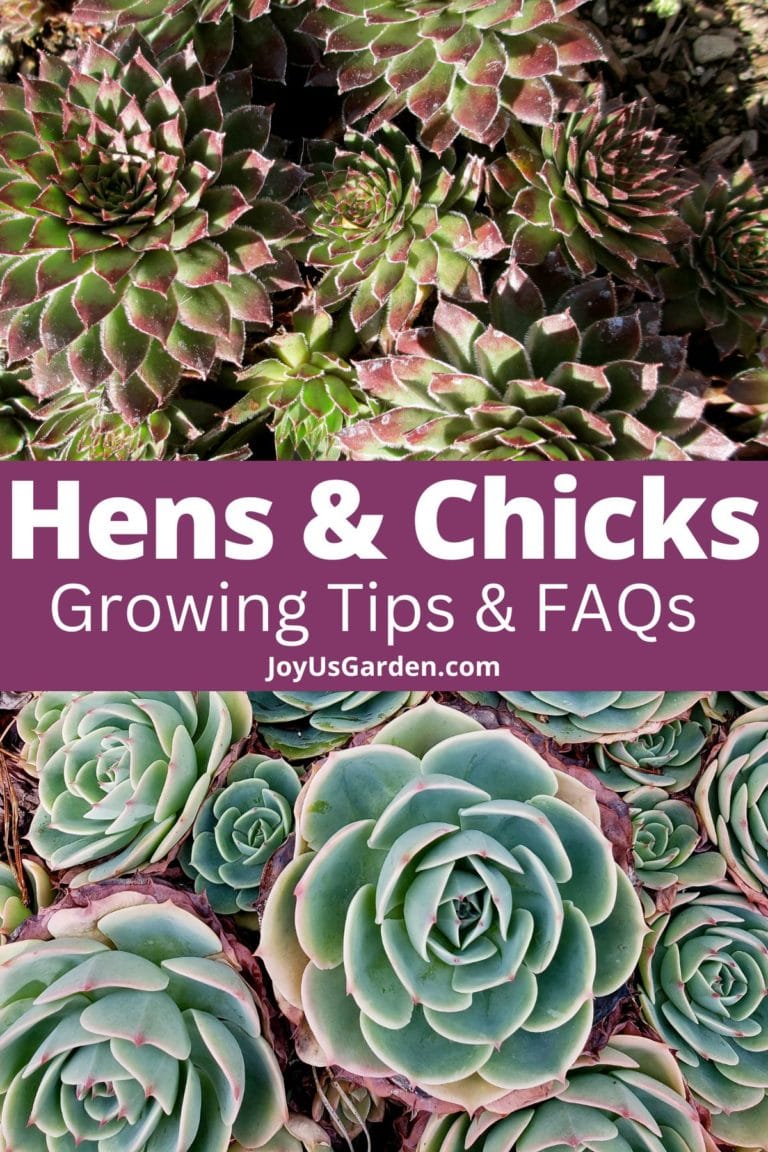
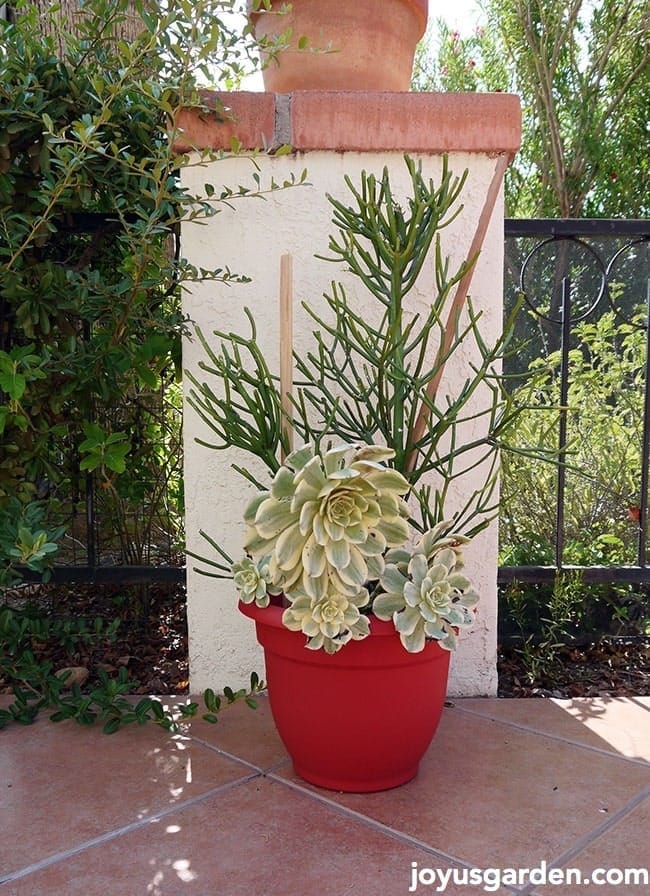
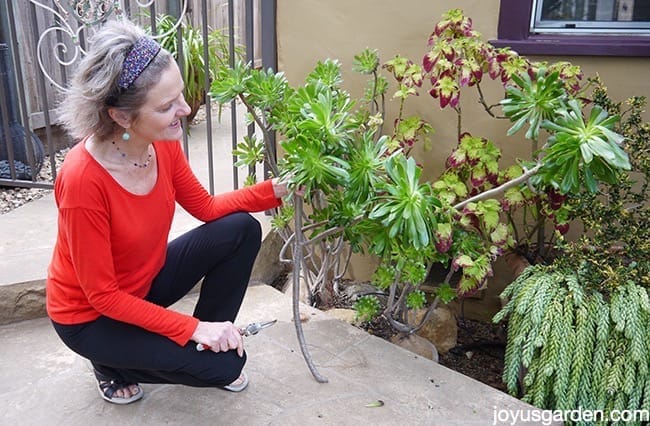
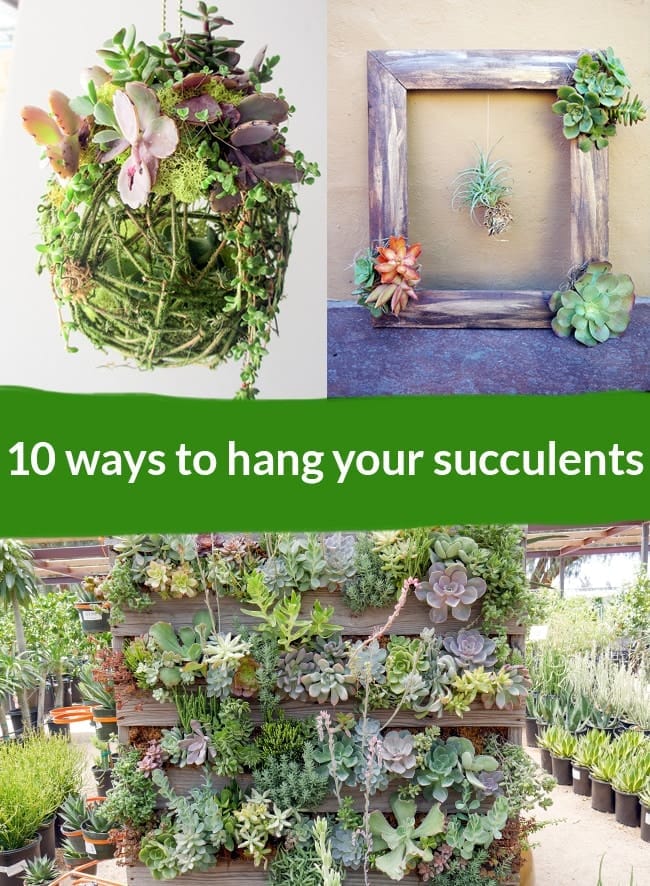

Oh that red pot is gorgeous! and what you did in the log <3